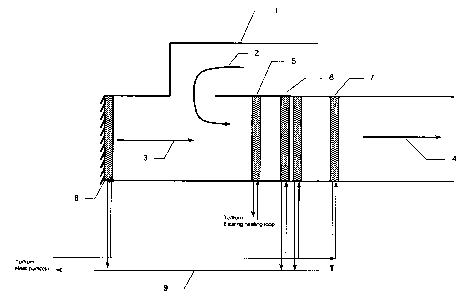Some of the information on this Web page has been provided by external sources. The Government of Canada is not responsible for the accuracy, reliability or currency of the information supplied by external sources. Users wishing to rely upon this information should consult directly with the source of the information. Content provided by external sources is not subject to official languages, privacy and accessibility requirements.
Any discrepancies in the text and image of the Claims and Abstract are due to differing posting times. Text of the Claims and Abstract are posted:
| (12) Patent Application: | (11) CA 2572418 |
|---|---|
| (54) English Title: | METHOD OF SUPPLYING HEAT PUMP ENERGY IN BUILDING RETROFITS |
| (54) French Title: | METHODE D'APPROVISIONNEMENT EN ENERGIE DES THERMOPOMPES DANS LES REAMENAGEMENTS DES IMMEUBLES |
| Status: | Deemed Abandoned and Beyond the Period of Reinstatement - Pending Response to Notice of Disregarded Communication |
| (51) International Patent Classification (IPC): |
|
|---|---|
| (72) Inventors : |
|
| (73) Owners : |
|
| (71) Applicants : |
|
| (74) Agent: | |
| (74) Associate agent: | |
| (45) Issued: | |
| (22) Filed Date: | 2006-12-27 |
| (41) Open to Public Inspection: | 2008-06-27 |
| Availability of licence: | N/A |
| Dedicated to the Public: | N/A |
| (25) Language of filing: | English |
| Patent Cooperation Treaty (PCT): | No |
|---|
| (30) Application Priority Data: | None |
|---|
Heat pumps, either air-source or ground source, provide a highly efficient
means of
delivering space heating and cooling. Typical solutions for retrofiting heat
pumps to
existing buildings' heating system are often costly and/or limits the
effectiveness of the
heat pump's ability to deliver heat to the building. The nature of the
invention consists
of delivering heat pump derived energy to the building through its ventilation
system.
Specially, heating/cooling coils supplied by the heat pump are installed
either in,
upstream or downstream of the building's air handling unit(s) (AHUs). The heat
pump
supplied coils thereby can provide base-level heating to the building via the
ventilation
air, essentially utilizing the ventilation system as a forced-air heating
system. The
process of adding heat coils and associated piping loop to the building's
ventilation is a
relatively minor retrofit, causing limited building disturbance and is an
inexpensive
retrofit.
Note: Claims are shown in the official language in which they were submitted.
Note: Descriptions are shown in the official language in which they were submitted.

2024-08-01:As part of the Next Generation Patents (NGP) transition, the Canadian Patents Database (CPD) now contains a more detailed Event History, which replicates the Event Log of our new back-office solution.
Please note that "Inactive:" events refers to events no longer in use in our new back-office solution.
For a clearer understanding of the status of the application/patent presented on this page, the site Disclaimer , as well as the definitions for Patent , Event History , Maintenance Fee and Payment History should be consulted.
| Description | Date |
|---|---|
| Time Limit for Reversal Expired | 2011-12-28 |
| Application Not Reinstated by Deadline | 2011-12-28 |
| Inactive: Adhoc Request Documented | 2011-09-29 |
| Deemed Abandoned - Failure to Respond to Maintenance Fee Notice | 2010-12-29 |
| Letter Sent | 2010-08-09 |
| Inactive: Office letter | 2010-02-25 |
| Reinstatement Requirements Deemed Compliant for All Abandonment Reasons | 2010-02-05 |
| Deemed Abandoned - Failure to Respond to Maintenance Fee Notice | 2009-12-29 |
| Application Published (Open to Public Inspection) | 2008-06-27 |
| Inactive: Cover page published | 2008-06-26 |
| Inactive: First IPC assigned | 2007-03-28 |
| Inactive: IPC assigned | 2007-03-28 |
| Inactive: IPC assigned | 2007-03-28 |
| Inactive: IPC assigned | 2007-03-28 |
| Inactive: Office letter | 2007-02-02 |
| Application Received - Regular National | 2007-01-30 |
| Filing Requirements Determined Compliant | 2007-01-30 |
| Inactive: Filing certificate - No RFE (English) | 2007-01-30 |
| Small Entity Declaration Determined Compliant | 2006-12-27 |
| Abandonment Date | Reason | Reinstatement Date |
|---|---|---|
| 2010-12-29 | ||
| 2009-12-29 |
The last payment was received on 2010-02-05
Note : If the full payment has not been received on or before the date indicated, a further fee may be required which may be one of the following
Please refer to the CIPO Patent Fees web page to see all current fee amounts.
| Fee Type | Anniversary Year | Due Date | Paid Date |
|---|---|---|---|
| Application fee - small | 2006-12-27 | ||
| MF (application, 2nd anniv.) - small | 02 | 2008-12-29 | 2008-11-14 |
| MF (application, 3rd anniv.) - small | 03 | 2009-12-29 | 2010-02-05 |
| Reinstatement | 2010-07-16 |
Note: Records showing the ownership history in alphabetical order.
| Current Owners on Record |
|---|
| FOREST K. PEARSON |
| Past Owners on Record |
|---|
| None |